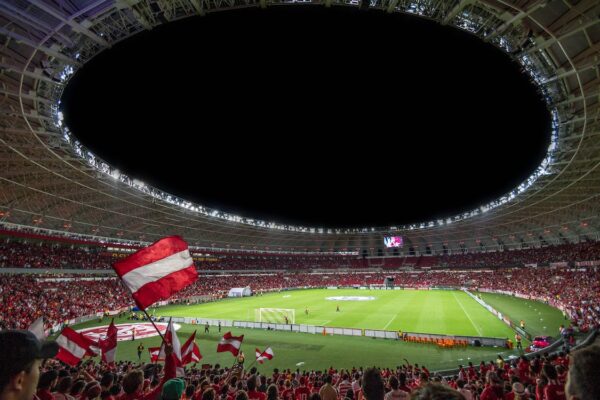Since the early days of soccer, the act of watching a live match in a stadium has always been one of the core elements of a fan’s experience. Some say, that, much like other entertainment experiences such as concerts, something about being in the presence of other fans who support the same team as they do creates a sense of community and togetherness that is hardly found anywhere else.
However, as time passes and technology advances at breakneck speed, bringing these experiences into our homes has long been a possibility and a reality for many of us. You don’t need to go to the movies to watch the latest blockbusters anymore and, similarly, you don’t need to abdicate the comfort of your home to feel the thrill of a sports game.
In this new digital environment, stadium owners and soccer teams are faced with a challenge: to maximise the in-stadium experience in order to get fans back into the venues. As a response to this, the stadium business has made use of technology in a number of different ways to generate fan engagement and ensure the future of its venues.

Source: Pexels – Campo De Futebol Verde E Branco à Noite
A Personalised Experience
One of the most common ways in which soccer has brought tech into its stadiums is through mobile apps. The advantages of installing a stadium or club’s mobile app start before a fan even sets foot in the stadium, with the ticket purchasing process. The accessibility and ease with which fans are able to secure tickets online through an app increase the likelihood of buying them and going to stadiums to see matches, as do app-exclusive offers and promotions such as rewards programs.
Other interactive features in stadium apps might also help fans plan their day at the stadium. For example, they might display the available food options, locate the nearest toilets, provide a digital map of the seats, etc. This helps fans make their way around the stadium in a simpler, hassle-free way, avoiding long queues and waiting times.
One important aspect to consider when it comes to mobile apps is connectivity, which remains a challenge for stadiums to make the most out of innovations like these. In gigantic venues like stadiums where thousands of users are connected and actively using these apps, delivering fast and high-quality Wi-fi should definitely be as much of a priority as developing those apps.
For instance, earlier this year, CITYPARK, the home of St Louis City SC, partnered with Cisco, a tech corporation specialising in digital connectivity, to develop a ground-breaking network that maximises Wi-fi speed, bandwidth and reliability in the stadium. St Louis City’s effort to enhance their fans’ stadium experience has matched their recent on-field performance. After a great start to the year, they’re currently priced to win the MLS cup at +2000 according to online Soccer Odds.
In turn, mobile apps are also a great way for stadium managers and clubs to implement segmentation strategies to drive revenue. By making fans’ preferences and consumer habits clearer, adverts and offerings can be much more personalised and thus better tailored for each supporter. Ticket ordering, seat choices, in-stadium purchases and other patterns give owners the data they need to segment fans into various consumer types. Consequently, this makes fans feel valued by the club they support and drives engagement.
Smart Stadiums: The Rise of Digital Signage
As the name indicates, signage corresponds to all displays that can be found in a stadium. It can range from scoreboards and wayfinding to billboards and security signs. It’s easy to see how this aspect of a matchday highly contributes to a more user-friendly experience in the stadium – the easier it is to find your exits or to check your team’s analysis monitor, the higher you’ll rate your experience in terms of convenience.
Improving the digital signage at a stadium is a way to make all these elements more interactive and immersive, boosting fans’ experience to the max. For instance, displaying highlights of the game or player stats is a great way to keep fans entertained during breaks. Displays can also be used in other ways to benefit fans, such as showing in-stadium directions or other useful information.
This is as beneficial for stadiums and teams as other strategies we’ve mentioned. A greater level of satisfaction from fans is likely to result in higher engagement from them, for instance, in the form of more in-stadium purchases, not to mention the opportunity that displays represent for added advertising.
A great example of a stadium that has used digital displays to their full potential is the SoFi Stadium in LA, which boosts an enormous double-sided video scoreboard, debuted in 2020. The largest ever built, it truly is an example of state-of-the-art digital signage. By ensuring that all viewers can see the field regardless of where they’re seated, the SoFi stadium has greatly enhanced their viewers’ experience – all thanks to tech.
To Infinity and Beyond with AR & VR
Augmented reality and virtual reality are currently considered great promises in sports tech to drive fan engagement and improve user experience. These technologies have already been used in sports in several ways, namely to plan construction for future stadiums, but their potential is incalculable.
As for the stadiums, there are various ways in which the fan experience could benefit from AR and VR. For instance, one of these uses could be a way to find fellow fans even if they’re sitting across from you in the stadium or to more easily find toilets or food stands. AR specifically could also be of great use to improve in-stadium entertainment – for example, during breaks or before matches begin.
A good example of this was the pregame ceremony at the Bank of America Stadium, where the Caroline Panthers had a mixed-reality panther climb on top of the stadium and jump over it before defeating the New York Jets.
Of course, cost is one of the great barriers to the implementation of VR and AR in sports and any industry. The price to pay for it, however, is understandable given its immense potential, and as with other industries, it’s only natural to assume that the sports business will keep investing in it.
Putting fans at the centre of the stadium experience starts with assuring the safety and comfort of all attendees. However, to truly go above and beyond, enhancing it requires club and stadium owners to invest in the modernisation of various aspects of their venues. For newer generations, soccer is about more than just watching a game than it ever was. For Gen-Zs specifically, soccer should be experienced in a more immersive way and, as technology advances, it consistently appears at the forefront of that experience, enriching it.
As fans’ expectations of their match-going experiences become increasingly more demanding, this trend is bound to stick around. This is arguably the biggest challenge faced by the stadium industry nowadays – to find new and innovative ways to deliver unique experiences that will keep team supporters coming back. Only time will tell what new otherworldly tech experts will marvel soccer fans with in the future

